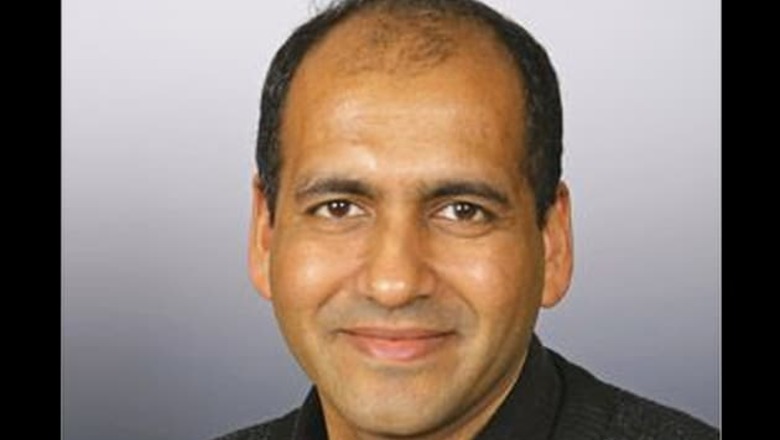
views
MV Ramana
Age: 45
Designation: Researcher in Science and Global Security at Nuclear Futures Laboratory and Program, Princeton University; member of International Panel on Fissile Materials and Science and Security Board, Bulletin of the Atomic Scientists
Education: PhD in Physics, Boston University; IIT-Kanpur; post-doctoral fellow, University of Toronto and Center for International Studies, MIT
Career: Author of 'The Power and the Promise: Examining Nuclear Energy in India'
Interests: Food, South India classical music
Q. You have a book on India's nuclear energy prospects coming out this year. What's the argument you're making?
The book looks at the history of nuclear power in India. The Department of Energy had made a series of projections for how much nuclear power would contribute to India's energy production over the past 60 years. These projections have not come through. I look at why projects have been delayed, what are the economics of nuclear power in India, the safety record and impact on health and the environment. It's an assessment of how the nuclear program has fared so far.
Q. India's leadership has said it is committed to nuclear energy despite Fukushima, and has set pretty lofty targets for making nuclear power a major source of India's energy: 470 gigawatts by 2050. Do you think they're likely to follow through?
No. The leadership is committed, but that's been the case since the 1950s. Every group of leaders has been committed to nuclear power, given it unlimited budget allocations, and yet it hasn’t happened. There’s no reason to expect it will happen in the future.
Kudankulam is a good example, and something to learn from. If there is to be an expansion of nuclear power, there will have to be many new sites and reactors, which will come at a cost of land and water for other purposes. Since the 1980s, each new site has met with protest, and it is likely to become more intense.
Many of the projections of future nuclear capacity are based on a technology called breeder reactors, which has been pursued by many countries since the 1950s, and in each it's been a failure. There is no reason to expect India will be different. This is an additional reason why achieving the nuclear power generation goals is unlikely.
The cost of generating nuclear power is higher than other energy sources. Historically, the nuclear establishment tried to compare itself with coal, and said that if you set up a power plant far from the coal mines, then you have to incorporate the cost of transporting coal. Once you do that, you find that the cost of a nuclear power is equal to that of a coal.
Initially, they said that if a coal mine was 600 km away, then nuclear plants are comparable in cost. By the 1980s, when the first plants were set up and generating, they said it would be 800 km. By the 1990s, it was 1,200 km from the coal mines. In 2005 or so, I looked at a recently commissioned hydroelectric plant and a coal plant and assumed that the coal was coming from 1,400 km away. Nuclear power still wasn't competitive. If the challenge is providing not just power but cheap power, nuclear isn't the answer.
Q. After Fukushima, the Indian Atomic Energy Commission chairman said reactors here are 100 per cent safe. Can that be true?
It's not a scientifically tenable statement. Heads of nuclear establishments make this kind of statements all the time, and it's worse than propaganda. There are various statements where they say we have to be confident about safety, and this confidence is something we should instil in our workers. One of the lessons from people who look at why accidents take place — not just in nuclear plants but in all systems — is that organisations that are too confident about safety are more at risk than those that are aware of risks.
Q. You've said that accidents are inevitable, and happen more often than risk assessments predict. Why is that?
You can lower the risk, but you can't eliminate it. The problem is two-fold. In the case of India right now, and the US, if the people who run and regulate plants are confident that accidents will not take place, they are unlikely to take (safety) measures.
Nuclear power plants are also extremely complex. It's extremely complicated to predict all possible failures. In the case of Fukushima, there were multiple failures, common-cause failures. The bottom line is that in a power plant there are multiple ways in which accidents can take place, and when you try to prevent one, you might increase the risk of another. It's very difficult to ensure complete safety.
Q. When we talk about risks, is Fukushima the best comparison? Earthquakes played a role there, as did the tsunami. Are the risks comparable for India?
It's true that in India the chances of an earthquake are much lower than in Japan. But, if you think about the history of nuclear accidents, the two accidents before Fukushima were Three Mile Island and Chernobyl. In both these cases, it was a purely internal cause. It’s the wrong lesson to learn from Fukushima and focus on tsunamis and earthquakes. They were the triggers, but you fundamentally have a system that is prone to accidents. That doesn't mean you can't have nuclear power, but the point is you can't wish away the possibility of accidents.
Q. You say it doesn't mean we can't have nuclear power. In your opinion, should we?
There is an opportunity cost to not pursuing other technology possibilities. In India, we could have been generating a lot more power from other sources. Nuclear energy should not be a high priority; it's time to deprioritise it to a minimum.
Nuclear power is special because of the potential for accidents. One implication of this is one should not pursue it without democratic consent, because it's something people fear, and, to some extent, for good reason. We can't decide on nuclear power before a national discussion or debate on how to deal with the energy crisis is carried out.
Q. Are there any signs of this debate taking place?
The debate isn't taking place, and one reason for that is the sense of crisis. When people say we are short of power and need to generate it right away, it doesn't give the mental space to carry out this kind of a debate.
Sadly, protests are the way in which this debate is taking place. People have to take to the streets and block entrances to the plants before they are heard. Kudankulam is a tragic illustration of how poor the democratic practices are. These people have opposed the plant from the beginning. They've not had a forum to express their grievances.
The one place where their voices are recorded is in the environmental impact assessment. Before a project is commissioned, they have to produce an environmental impact assessment, put it to the public for comment, and, by law, have a public meeting. The report is supposed to be used in the decision on whether to go ahead with the plant or not.
In 2007, there was a hearing that I attended, with about 7,000 people. Almost unanimously they were opposed to the project. What the Ministry of Environment did is say, 'The project is fine, we are clearing it, we had various questions and they have answered all our questions.' The project was commissioned without the support of the people. In the one democratic forum where people could participate, their views were not heard. They have no option but to go for this massive protest.




















Comments
0 comment